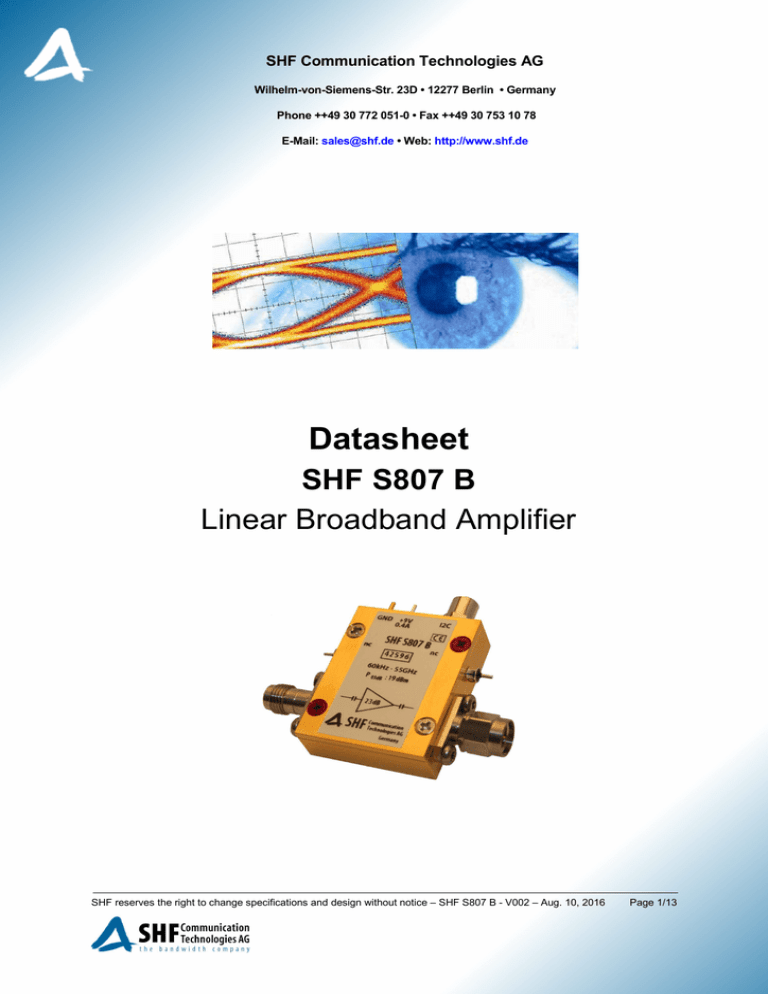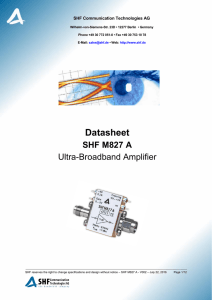Datasheet SHF S807 B - SHF Communication Technologies AG
advertisement

SHF Communication Technologies AG Wilhelm-von-Siemens-Str. 23D • 12277 Berlin • Germany Phone ++49 30 772 051-0 • Fax ++49 30 753 10 78 E-Mail: sales@shf.de • Web: http://www.shf.de Datasheet SHF S807 B Linear Broadband Amplifier SHF reserves the right to change specifications and design without notice – SHF S807 B - V002 – Aug. 10, 2016 Page 1/13 Description The SHF S807 B is the improved successor to the popular SHF S807 linear driver amplifier. It offers more bandwidth and a better group delay than the S807. The bandwidth improvement offers operation up to 56 GBaud. The important features of ultra-fast rise and fall time, high linear output power (P1dB) and high third order intercept point (IP3), render the amplifier well suited for PAM4, optical 16QAM, and OFDM signal generation applications. The S807 B is a two-stage amplifier design, using proprietary monolithic microwave integrated circuits (MMICs) inside special carriers to achieve ultra-wide bandwidth and low noise performance. An internal voltage regulation protects the amplifier against accidental reverse voltage connection and makes it robust against line voltage ripple. A feature has been built-in to enable the amplifier gain and crossing to be controlled externally via software. Ease of Use Upon delivery, the amplifier is already pre-set to deliver maximum gain, maximum output amplitude and nominally 50% crossing. These settings can be modified in an easy to use graphical software interface, as shown below. For connecting the amplifier to the computer, the USB to I2C converter cable, as well as the required software are included with each amplifier with no extra charge. Once new settings are stored on the device the amplifier will remember the settings until further changes are made. There is no need to connect a computer to the device unless gain, maximum amplitude or crossing adjustments are to be made. The software is available for download at www.shf.de . GUI of the SHF amplifier control software Available Options 1 01: DC return on input (max. ±1.75 V, max. 35 mA) 02: Built-in bias tee on input (max. ±9 V, max. 220 mA) 03: DC return on output (max. ±1.75 V, max. 35 mA) 1 1 04: Built-in bias tee on output (max. ±7 V, max. 220 mA) 1 MP: Matches the phase of two amplifiers 1 The options 01 & 02 or 03 & 04 cannot be combined. If an option is chosen, the maximum gain might be reduced by up to 1 dB and the low frequency 3 dB Point might be increased up to 75 kHz. SHF reserves the right to change specifications and design without notice – SHF S807 B - V002 – Aug. 10, 2016 Page 2/13 Specifications – SHF S807 B Parameter Unit Symbol Min Typ Max Conditions Maximum RF Input Power in Operation dBm V Pin max 4 1 peak to peak voltage Maximum RF Input Power without Power Supply dBm V Pin max 10 2 peak to peak voltage Absolute Maximum Ratings DC Voltage at RF Input V ±9 DC Voltage at RF Output V ±7 Supply Voltage V Case Temperature 2 Tcase 8 °C 10 12 40 0.4 A, reverse voltage protected 50 Electrical Characteristics (At 40°C case temperature, unless otherwise specified) High Frequency 3 dB Point GHz fHIGH Low Frequency 3 dB Point kHz fLOW Gain dB S21 Max. Gain Reduction dB Output Power at 1 dB Compression dBm V Output Power at 2 dB Compression Output Power at 3 dB Compression 55 60 non-inverting 22 23 -2.5 -3 P01dB 15 3.5 16 4 10 MHz…20 GHz dBm V P02dB 17 4.5 18 5 10 MHz…20GHz dBm V P03dB 19 5.6 19.5 6 10 MHz…20 GHz 3 Order Intercept Point dBm IP3 28 Max. RF Input for Linear Operation dBm V Pin lin rd measured at Pin=-27 dBm -4 Control via software interface peak to peak voltage peak to peak voltage peak to peak voltage -8 0.25 I.e. Pout ≤ P01dB peak to peak voltage Pin ≥ - 2 dBm Max. Output Power Reduction dB Crossing might need to be readjusted by using the crossing control feature. 1 Control via software interface 2 Crossing Control Range % Input Return Loss dB -4 S11 4 -12 -7 -10 -5 Control via software interface < 30 GHz < 50 GHz If operated with heat sink (part of the delivery) at room temperature there is no need for additional cooling. SHF reserves the right to change specifications and design without notice – SHF S807 B - V002 – Aug. 10, 2016 Page 3/13 Parameter Unit Symbol Output Return Loss dB S22 Min Typ Max Conditions -12 -10 < 40 GHz 20%...80%, 3 V ≤ Vout ≤ 4 V Rise Time/Fall Time ps tr/tf 8 13.5 Deconvoluted Full Setup 3, 4 3 3 V ≤ Vout ≤ 4 V Jitter fs Group Delay Ripple ps Power Consumption W JRMS 440 550 3 3, 4 580 650 Deconvoluted ±50 40 MHz…40 GHz, 160 MHz aperture Full Setup 3 9 V supply voltage Mechanical Characteristics 5 Input Connector 1.85mm (V) female Output Connector 1.85mm (V) male 3 5 Measured with the following setup: SHF 613 A DAC -> DUT (SHF S807 B) -> Agilent 86100A with 70 GHz sampling head and precision time base. 4 Calculation based on typical results of setup without DUT : / !" = = ( / ( !" ) −( / ) −# !" / / ) = $ = ( ( / !" ) − 11 ) − 300' 5 Other gender configurations are available on request. Other connector types, e.g. 2.92mm (K) or Mini-SMP (GPPO) connectors, are also available but may impact the bandwidth and reflection characteristic. SHF reserves the right to change specifications and design without notice – SHF S807 B - V002 – Aug. 10, 2016 Page 4/13 Typical S-Parameters, Group Delay and Phase Response Aperture of group delay measurement: 160 MHz SHF reserves the right to change specifications and design without notice – SHF S807 B - V002 – Aug. 10, 2016 Page 5/13 Typical Binary Waveforms Eye Amplitudes: Input ~200 mV ⇒Output ~3 V Measurements at 50 and 56 Gbps had been performed using a SHF 613 A DAC in binary mode and an Agilent 86100A DCA with Precision Time Base Module (86107A) and 70 GHz Sampling Head (86118A). Slower input signals had been taken from a SHF 611 C DAC. The measurement at 50 Gbps will be part of the inspection report delivered with each particular device. Input Signal @ 32 Gbps Output Signal @ 32 Gbps Input Signal @ 43 Gbps Output Signal @ 43 Gbps Input Signal @ 50 Gbps Output Signal @ 50 Gbps SHF reserves the right to change specifications and design without notice – SHF S807 B - V002 – Aug. 10, 2016 Page 6/13 Input Signal @ 56 Gbps Output Signal @ 56 Gbps Eye Amplitudes: Input ~400 mV ⇒Output ~5.2 V The Measurements below had been performed using an SHF 12103A and an Agilent 86100A DCA with Precision Time Base Module (86107A) and 70 GHz Sampling Head (86118A). Input Signal @ 56 Gbps Output Signal @ 56 Gbps SHF reserves the right to change specifications and design without notice – SHF S807 B - V002 – Aug. 10, 2016 Page 7/13 Typical 4-Level Waveforms Eye Amplitudes: Input ~200 mV ⇒Output ~3 V Measurements at 50 and 56 GBaud had been performed using a SHF 613 A DAC and an Agilent 86100A DCA with Precision Time Base Module (86107A) and 70 GHz Sampling Head (86118A). Slower input signals had been taken from a SHF 611 C DAC. The measurement at 50 GBaud will be part of the inspection report delivered with each particular device. Input Signal @ 32 GBaud Output Signal @ 32 GBaud, ~3 Vpp Input Signal @ 43 GBaud Output Signal @ 43 GBaud, ~3 Vpp Input Signal @ 50 GBaud Output Signal @ 50 GBaud, ~3 Vpp SHF reserves the right to change specifications and design without notice – SHF S807 B - V002 – Aug. 10, 2016 Page 8/13 Input Signal @ 56 GBaud Output Signal @ 56 GBaud Eye Amplitude: Input ~300 mV ⇒Output ~4 V Input Signal @ 56 GBaud Output Signal @ 56 GBaud SHF reserves the right to change specifications and design without notice – SHF S807 B - V002 – Aug. 10, 2016 Page 9/13 Typical Low Frequency Response (<1 MHz) Typical Saturation power Top (red): 3 dB compression; Middle (green): 2 dB compression; Bottom (blue): 1 dB compression SHF reserves the right to change specifications and design without notice – SHF S807 B - V002 – Aug. 10, 2016 Page 10/13 Mechanical Drawing with Heat Sink 2x M4x 5 mm 9 9.9 9.5 27 13 26.5 9.5 23.2 12.2 10.4 7.1 GND +9V 0.4A I2C 10.4 5.5 3.2 3.5 9.9 73 36.5 26.5 9.5 9.9 27 14.3 13 all dimensions in mm Pin assignment might change if a bias tee option is chosen. Thermal resistance of heat sink approx. 6 K/W For permanent mounting remove the heat sink from the amplifier. In that case please ensure that adequate cooling of the amplifier is guaranteed. It is recommended to use thermal paste or a thermal gap pad for the mounting. In order to separate the heat sink from the amplifier, remove the four screws on the heat sink. Please note, thermal paste is used between the heat sink and the amplifier housing. SHF reserves the right to change specifications and design without notice – SHF S807 B - V002 – Aug. 10, 2016 Page 11/13 Mechanical Drawing without Heat Sink 23.6 4x M2x 5 mm 9.8 5 5.4 21 10 23.5 35 +1 42 -0 2x M2x 4 mm 5.1 21.2 12.4 10.2 27.9 GND +9V 0.4A 37.3 24 I2C 12.4 5 39.7 2 40 5.4 9.8 23.5 5 5.4 10 all dimensions in mm Pin assignment might change if a bias tee option is chosen. Please ensure that adequate cooling of the amplifier is guaranteed. SHF reserves the right to change specifications and design without notice – SHF S807 B - V002 – Aug. 10, 2016 Page 12/13 User Instructions ATTENTION! Electrostatic sensitive GaAs FET amplifier 1. To prevent damage through static charge build up, cables should be always discharged before connecting them to the amplifier! 2. Attach a 50 Ohm output load before supplying DC power to the amplifier! 3. The supply voltage can be taken from any regular 8…12 V, 0.4 A DC power supply and can be connected to the supply feed-through filter via an ON / OFF switch. 4. Using a 3 dB or 6 dB input attenuator will result in a 6 dB or 12 dB increase of the input return loss. For minimal degradation of amplifier rise time, these attenuators should have a bandwidth specification of greater 50 GHz (V/ 1.85mm attenuators)! 5. An input signal of about 0.6 Vpp will produce saturated output swing of about 5.6 Vpp. 6. Higher input voltages will drive the amplifier’s output stage into saturation, leading to waveform peak clipping. 8. Saturated output voltages can only be used without damage while the amplifier is connected to a 50 Ohm precision load with a VSWR of less than 1.2 or better than 20 dB return loss up to 40 GHz. 9. While using a reflective load the output voltage has to be reduced to a safe operating level according to the magnitudes of the reflections. ATTENTION: At radio frequencies a capacitive load can be transformed to an inductive one through transmission lines! With an output stage driven into saturation this may lead to the immediate destruction of the amplifier (within a few ps)! 10. The input voltage should never be greater than 1 Vpp equivalent to 4 dBm input power. The input voltage without DC power supplied to the amplifier should never be greater than 2 Vpp equivalent to 10 dBm input power. SHF reserves the right to change specifications and design without notice – SHF S807 B - V002 – Aug. 10, 2016 Page 13/13

